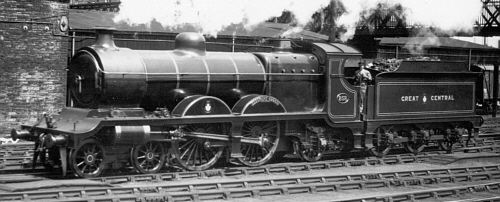The Robinson C5 (GCR Classes 8D & 8E) 4-4-2 Atlantics

These four locomotives were an attempt at implementing compound expansion by Robinson. Compound expansion was believed to be a good way of improving efficiency, but it was never very popular in Britain. The most successful implementation was that of Walter Smith who designed the LMS Compound 4-4-0s that survived into British Railways (BR) ownership. Smith introduced this particular system of compound expansion whilst at the North Eastern Railway's (NER) Gateshead Works. In 1898 he rebuilt 4-4-0 No. 1619 as a three cylinder compound expansion locomotive (LNER D19 4-4-0). Robinson was impressed by the reports of this locomotive's success, and ordered two W.M. Smith-compound Atlantics based on his C4 Atlantic. Robinson's experiment may have also been influenced by the Great Western Railway's (GWR) purchase of the compound expansion de Glehn Atlantics from France.
The first two C5s were built in December 1905 and February 1906, and a second pair was built in December 1906.
The central high pressure cylinder drove the leading coupled axle, resulting in the cylinder being positioned far forward of the other two cylinders. Stephenson motion was used on all three cylinders, with a 10in diameter W.M. Smith-pattern piston valve on the central cylinder. The outside cylinders had unbalanced slide valves. All three sets of motion were driven from the rear coupled axle.
The C5's compound expansion resulted in a coal saving of about 2 to 2.5lb of coal per mile, when compared to the simple expansion C4. This slight advantage was negated by the extra cost and complexity of a compound third cylinder. Robinson introduced superheating a few years later, and this produced substantial improvements in efficiency without the complexity of compound expansion. Compound expansion was not developed any further by the GCR.

A Schmidt superheater was fitted to No. 365 in 1911. A 24-element Robinson superheater was fitted to No. 364 in 1913. These were replaced with 22-element Robinson superheaters in March 1920 and March 1923 respectively. No. 259 was superheated in 1921, and No. 5258 was superheated in 1927.
The LNER cut the C5s down to their Composite Gauge to remain standard with the C4s, rather than to allow operation on non-GCR routes. As it turns out, this work was required to allow running on the electrified route from Wath to Manchester.
The C5s were only ever allocated to Gorton, Leicester, and Immingham. Until 1920, they were allocated to Gorton to haul top-link express passenger trains to Marylebone. The C5s also hauled a lot of excursion services. During the 1920s, the C5s operated out of Leicester as principal express locomotives. They were popular at Leicester and ran well, although efficiency figures suggest that by this time the superheated C4s were slightly more efficient than the superheated C5.
In 1932, the C5s were moved to Immingham, where they would remain until withdrawal. By now, they were hauling more of the stopping services. They entered storage from 1938 to 1939, but re-entered service for World War 2. They were regularly used on the Cleethorpes to Doncaster services, but switched to the Retford services in 1945. All of these services were short distance stop-and-start, and were considered unsuitable for a compound expansion locomotive. With large numbers of the Thompson B1 4-6-0s entering service, the C5s were rapidly withdrawn between 1946 and 1947.
Other than the fitting of superheaters, the C5s received no major alterations. Unlike many British compound designs, they could be considered a success even though the improvements in efficiency were small.
Technical Details
The following details are for the locomotives with superheaters fitted.
| Cylinders: | Inside: | 19x26in (high pressure) |
| Outside: | 21x26in (low pressure) | |
| Valves: | Inside: | Slide |
| Outside: | 10in piston | |
| Motion: | Stephenson | |
| Boiler: | Max. Diameter: | 5ft |
| Pressure: | 180psi | |
| Diagram No.: | 15 | |
| Heating Surface: | Total: | 1745 sq.ft. |
| Firebox: | 154 sq.ft. | |
| Superheater: | 242 sq.ft. (22x 1.063in) | |
| Tubes: | 885 sq.ft. (110x 2in) | |
| Flues: | 464 sq.ft. (22x 5.25in) | |
| Grate Area: | 26.24 sq.ft. | |
| Wheels: | Leading: | 3ft 6in |
| Coupled: | 6ft 9in | |
| Trailing: | 4ft 3in | |
| Tender: | 4ft 4in | |
| Tractive Effort: | (HP:66.67%, LP: 25%) | 13,321lb |
| Wheelbase: | Total: | 51ft 10in |
| Engine: | 27ft 9.5in | |
| Tender: | 13ft 0in | |
| Weight (full): | Total: | 121 tons 12cwt |
| Engine: | 73 tons 6cwt | |
| Tender: | 48 tons 6cwt | |
| Max. Axle Load: | 18 tons 10cwt |
Preservation
The last C5 was withdrawn in 1947, and none survived into preservation.
Models
In the past, Leinster and McGowan have both produced kits of the C5 in 4mm scale (OO gauge). Both are currently unavailable.
Gladiator sell a kit for 7mm scale (O gauge).
Locomotives
| LNER No. | 1946 No. | Build Date | Disposal Date | Named | Name |
| 5258 | 2895 | 12/1905 | 12/1946 | 12/1927 | The Rt. Hon. Viscount Cross GCB GCSI |
| 5259 | 2896 | 2/1906 | 4/1947 | 10/1921 | King Edward VII |
| 5364 | 2897 | 12/1906 | 12/1947 | 3/1913 | Lady Faringdon |
| 5365 | 2898 | 12/1906 | 8/1947 | 5/1911 | Sir William Pollitt |
Note: No. 5364 Lady Faringdon was named Lady Henderson from 1913 to 1917.
No. 2895 was withdrawn on 31st December 1946, but was included in the statistics for 1947.
Acknowledgements
Thank you to Dennis Butler for the pre-Grouping photograph of No. 258 The Rt. Hon. Viscount Cross GCB GCSI.